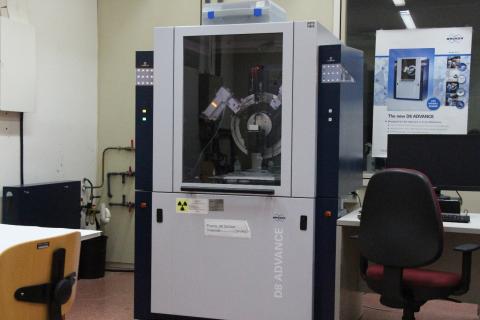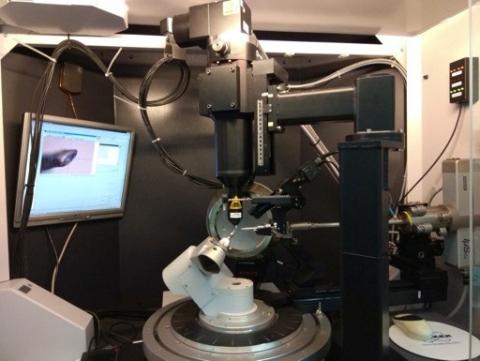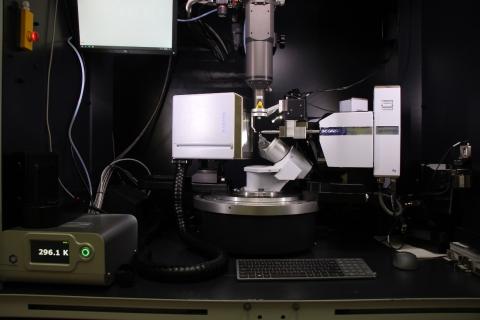X-Ray Diffraction
Scientist in Charge:
Dr. Felipe Gándara Barragán (Tenured Scientist)
Technician
Dr. Fátima Esteban Betegón (Specialized Technician)
Dr. Raluca Loredana Vasile (Specialized Technician)
Contact
+34 913349000 ext. 437023 / 437204
+34 917166025 (direct number)
Location
Powder Diffractometers: laboratory 023-025
Single-crystal diffractometers: laboratories 049 and 051
The X-ray Diffraction Laboratory at the Materials Science Institute of Madrid offers access to equipment for crystallographic characterization through different X-ray diffraction techniques to both ICMM and external users.
Measurements:
Powder X-ray diffraction analysis:
- Reflection geometry in any of three dedicated PXRD diffractometers. Samples in powder form are prepared on a flat surface and Theta/2theta scans are collected in the selected range, between 2Theta = 2.5º and 120º
- Micro X-ray diffraction (µDRX): allows precise measurements over very small areas, facilitating analysis used with either a small or non-homogenous sample with varying composition, lattice strain or preferred orientation of the crystallites. The analysis area is selected using a video camera with the aid of a laser pointer which, together with collimators of different sizes, produces an incident X-ray beam with diameters of 0.5, 0.3, or 0.1 mm. In addition, an xyz motorized sample stage allows to scan different areas of samples.
- Transmission geometry: Samples are prepared in sealed glass capillaries, and diffraction patterns are collected with a two-dimensional detector, with the selected Cu, Mo, or Ag radiation from a microfocused source. Useful for analysis of sensitive samples, or when only small amount is available.
Single crystal X-ray diffraction analysis:
- Single crystal samples, for full structural analysis, with selected wavelength from Cu, Mo, or Ag radiation. Measurements include data acquisition and reduction. Data collection can be carried out at selected temperature between r.t. and 30 K.
Equipment
Three Powder Diffractometers


Two Single-crystal Diffractometers


Extras: 1) sample cooling module with gas compressor capable of cooling down to 90k with nitrogen gas and down to 30 K with helium gas (model N-Helix with 800 series controller from OXFORD CRYOSYSTEM) and 2) cell for high-pressure measurements.
They allow for the identification of crystalline phases present in solid samples and the analysis of certain crystallographic parameters.
In addition, the diffraction service provides its user groups with access to crystallographic databases, such as CSD or ICSD. Recently, the service has acquired new licenses for diffraction data analysis programs, such as EVA, TOPAS, or LEPTOS. The service's computer equipment is available to users, both for equipment control and for data analysis and processing.
Allowed samples
Powder diffraction: samples are in powder form, with amount depending on sample nature, typically between 20 and 200 mg. Samples can be prepared in the diffraction lab. For measurements in transmission geometry, samples are prepared inside X-ray transparent glass capillaries with diameters between 0.1 mm and 1.0 mm.
Single-crystal diffraction: Crystals are selected with available optical microscope. Crystals with sizes from ~ 10 µm (depending on sample nature and composition).
Protocols
The service has a periodic schedule to carry out verifications with standard samples in the equipment, which allows to improve the reliability of the data obtained, and to know the state of the equipment. These control measurements are also made after a modification of the optical configuration of the diffractometer, or any other intervention, which allows to study if there has been any impact on the final result.
Instituto de Ciencia de Materiales de Madrid (ICMM)
Sor Juana Ines de la Cruz, 3
Cantoblanco, 28049
Madrid, España
Telephone: (+34) 91 334 90 00
Email: @email
Communication Office: @email

Acknowledge the Severo Ochoa Centres of Excellence program through Grant CEX2024-001445-S/ financiado por MICIU/AEI / 10.13039/501100011033

Contacto | Accesibilidad | Aviso legal | Política de Cookies | Protección de datos


